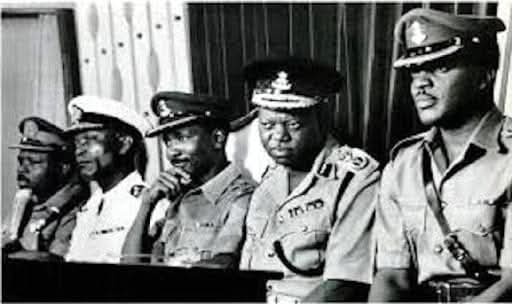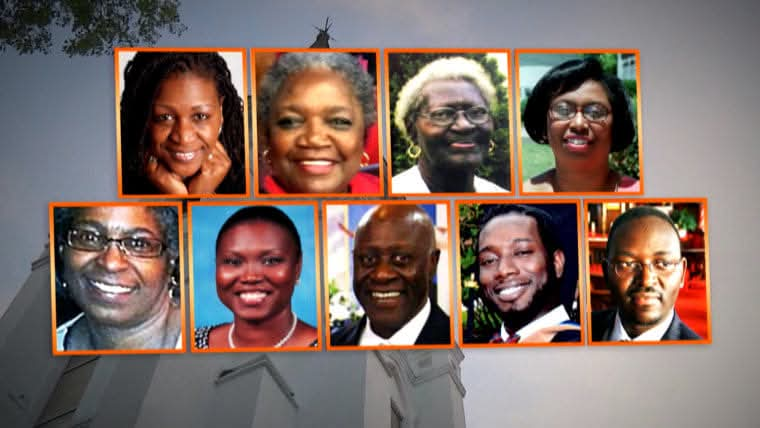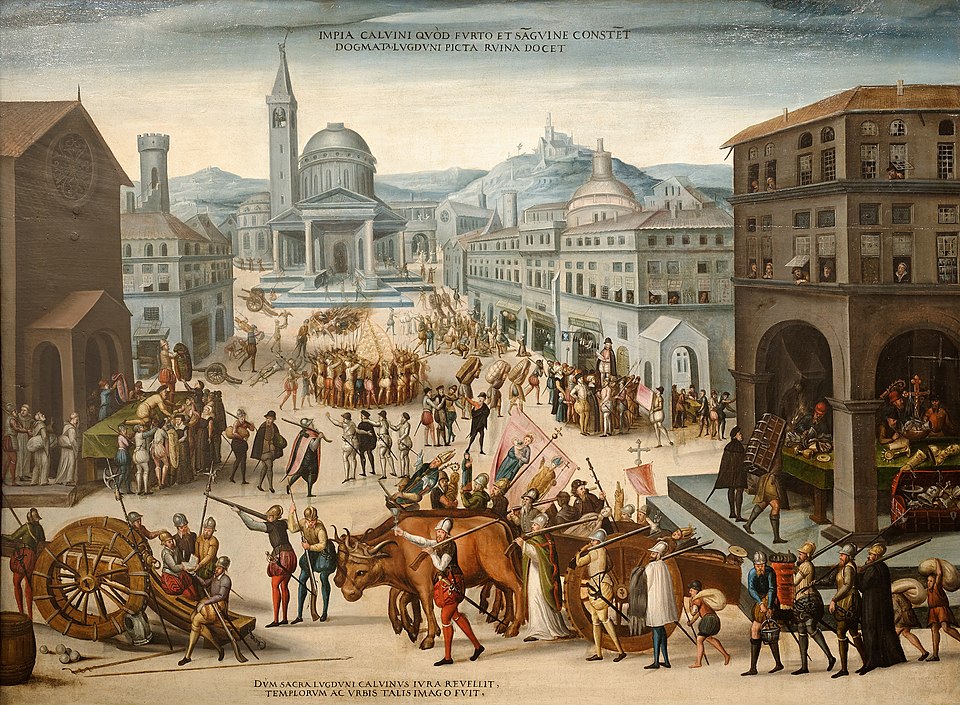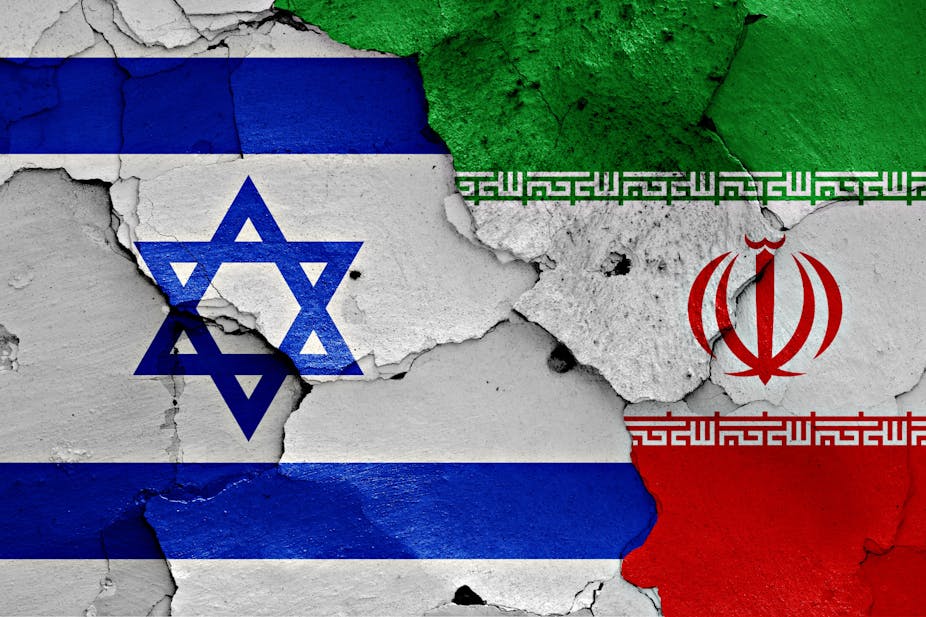MILITARY RULE: The History of Coup D'etat in Nigeria

Did you know that in less than 30 years, a total of nine military coup took place in the history of Nigeria with the largest execution of coup plotters recorded in the Orkar coup of 1990 wherein 42 persons were condemned to death by firing squad?
According to Wikipedia, a coup d'état or simply a coup, is typically an illegal and overt attempt by a military organization or other government elites to unseat an incumbent leadership. A self-coup is said to take place when a leader, having come to power through legal means, tries to stay in power through illegal means. By one estimate, there were 457 coup attempts from 1950 to 2010, half of which were successful. Most coup attempts occurred in the mid-1960s, but there were also large numbers of coup attempts in the mid-1970s and the early 1990s. Coups occurring in the post-Cold War period have been more likely to result in democratic systems than Cold War coups, though coups still mostly perpetuate authoritarianism.
Here are a history of the various coups that occurred in Africa's most populace country, Nigeria.
◼️ FIRST COUP (1966)
On January 15, 1966, Chukwuma Kaduna Nzeogwu led the first ever-military coup in Nigeria that led to the death of Sir Ahmadu Bello, the Sardauna of Sokoto and Premier of Northern Nigeria, Chief S.I. Akintola, the Premier of Western Region, Sir Abubakar Tafawa Balewa, Prime Minister of Nigeria, Chief Festus Okotie-Eboh, Federal Minister of Finance and other military officers. The coup was poorly carried out in certain parts of the country and there was a strong accusation of tribalism. The Northern People accused Chukwuma as well as his fellow coup plotters of staging an Igbo coup. This is because most of the officers killed during the coup were those from other part of the country. The then general officer commanding the Nigerian army, Major-General Johnson Thomas Ununakwe Aguiyi Ironsi was sworn-in as the Military Head of State of Nigeria.
◼️ SECOND COUP (1966)
On the night of 29 July 1966, northern soldiers at Abeokuta barracks mutinied, thus precipitating a counter-coup, which may very well have been in the planning stages. A group among the officers supported secession and thus gave the code name of the coup 'Araba' meaning secession in Hausa. However, after the success of the counter-coup, a group of civilians including the Chief Justice Adetokunbo Ademola, Sule Katagum, head of the Federal Public service and Musa Daggash, Permanent Secretary, defense convinced the plotters including Muhammed about the advantages of a union. The counter-coup led to the installation of Lieutenant-Colonel Yakubu Gowon as Supreme Commander of the Nigerian Armed Forces, despite the intransigence of Muhammed who wanted the role of Supreme Commander for himself. However, as Gowon was militarily his senior, and finding a lack of support from the British and American advisors, he caved in. Gowon rewarded him by confirming his ranking (he had been an acting Lt. Colonel until then) and his appointment (Inspector of Signals). The acceptance of Gowon as the Head of State was not supported by all the key military leaders, in particular, Odumegwu Ojukwu, military governor of the Eastern Region. The coup led to the death of Major-General J.T.U. Aguyi-Ironsi, Head of State, Col. Francis Adekunle Fajuyi Military Governor, Western region and other military officers.
◼️ THIRD COUP (1975)
On 29 July 1975, General Yakubu Gowon was overthrown while attending the 12th summit of the Organisation of African Unity (OAU) in Kampala, Uganda. General Murtala Muhammed also masterminded this coup. In this coup, no lives were lost. General Murtala Muhammed assumed power in July 1975. Muhammed took power as the new Military Head of State. Brigadiers Obasanjo (later Lt. General) and Danjuma (later Lt. General) were appointed as Chief of Staff, Supreme HQ and Chief of Army Staff, respectively.
◼️ FOURTH COUP (1976)
On 13 February 1976, six months later, Lieutenant-colonel Bukur Suka Dimka with his loyalist stage an abortive coup which claimed the lives of three officers; General Murtala Muhammed, Head of State, Col. Ibrahim Taiwo, Governor of Kwara State and Lt. Akintunde Akinsehinwa, ADC to Muhammed. This led to their arrest and subsequent execution of one civilian and 38 soldiers, including Major-General Illya Bisalla, five colonel, four majors and other officers for their role in the failed coup. Civilians involved in the coup include, Abdulkareem Zakari, a staff of Radio Nigeria, Lagos and Helen Gomwalk, sister-in-law of Joseph Gomwalk, were tried by military tribunal and punished. Zakari was executed for his involvement in the coup while Helen Gomwalk bagged a life sentence. She was later given amnesty by the Shehu Shagari administration.
◼️ FIFTH COUP (1983)
The Nigerian military coup of 1983 took place on December 31 of that year. It was coordinated by key officers of the Nigerian military and led to the ousting of the democratically elected government of President Shehu Shagari and the installation of Major General Muhammadu Buhari as head of state. This coup led to the death of a loyal officer to the government, Brigadier Ibrahim Bako (then Director of the Army Faculty at the Armed Forces Command and staff College, Jaji and acting GOC 1 Mechanised Division, Kaduna. Bako was tasked by the coup conspirators with arresting President Shehu Shagari presumably after Shagari's Brigade was killed by Col Tunde Ogbeha. Author Max Siollun notes that Bako was chosen for the arresting role because Bako's father was a personal friend to Shagari. Unknown to Bako was the fact that the coup plot had leaked to President Shagari whose guards were on high alert. After arriving at the Presidential residence (in non military attire) with an armed detachment to arrest the President, Bako was shot dead while sitting in the passenger side of a UNIMOG utility truck, in an ensuing fire fight between troops from Bako's detachment and the Brigade of Guards soldiers under the command of Captain Augustine Anyogo.
◼️ SIXTH COUP (1985)
On 27 August 1985, Babangida led a palace coup which terminated the Buhari’s 20 months reign. The 1985 Nigerian coup d'état was a military coup which took place when a faction of mid-level Armed Forces officers, led by the Chief of Army Staff General Ibrahim Babangida, overthrew the government of Major General Muhammadu Buhari (who himself took power in the 1983 coup d'état). Buhari was then detained in Benin City until 1988. Babangida justified the coup by saying that Buhari failed to deal with the country's economic problems by implementing Buharism, and promised "to rejuvenate the economy ravaged by decades of government mismanagement and corruption". Babangida then replaced the ruling Supreme Military Council (SMC) with a new Armed Forces Ruling Council (AFRC), which lasted until 1993. The regime survived a coup attempt in 1990.
◼️ SEVENTH COUP (1986)
In 1986, Major-General Mamman Vatsa led an abortive coup to overthrown the government of President Babangida. On 5 March 1986, he was executed by the military regime of General Ibrahim Babangida (who was his childhood friend) following a military tribunal conviction for treason associated with an abortive coup.
◼️ EIGHTH COUP (1990)
On 22 April 1990, Gideon Orkar staged an abortive coup to unseat the government of Ibrahim Babangida. The coup attempt has been describe as one of the bloodies coup and it was the largest execution of coup plotters in the nation’s history. This led to the death of nine loyal Soldiers. 69 soldiers of various ranks were accused of treason and they were killed by firing squad. The second in command and Chief of General Staff, Vice-admiral Augustus Aikhomu, revealed that at least three of the plotters of the April 22 coup were arrested, cautioned and released in 1987 over an alleged coup plot to overthrow the government. They were G.T. Nyiam, a Lieutenant Colonel, S.D. Mukoro and Gideon Orkar, both majors. They were later released. Aikhomu also said that the officers regrouped once again in January to overthrow the government and had intended to kill not only the president, but also, the AFRC members and military governors, all civilian members of the council of ministers and senior military and police officers. The suspects were later tried by the treason and other offences special military tribunal headed by Ike Nwachukwu, Major-General and General Officer Commanding the 1 Mechanised Division of the Nigerian Army, Kaduna. After the trial, 42 persons were found guilty and condemned to death by firing squad. This was the largest execution of coup plotters in Nigeria’s history breaking the record of the 1976 coup led by Buka Suka Dimka in which 32 officers and men were executed.
◼️ NINTH COUP (1993)
The 1993 Nigerian coup d'état was a bloodless military coup which took place in Nigeria on 17 November 1993 when the Armed Forces, headed by Defence Minister General Sani Abacha, forced Interim President Chief Ernest Shonekan to resign. Shonekan assumed the interim presidency on 26 August 1993, succeeding General Ibrahim Babangida as head of state, in the aftermath of Babangida's annulment of the 12 June 1993 presidential election. In a nationwide broadcast following the coup, Abacha cited the stagnant nature of Shonekan's government, and him being unable to manage the democratic process in the country as a cause of his resignation. In September 1994, Abacha issued a decree that placed his government above the jurisdiction of the courts, effectively giving him absolute power. Another decree gave him the right to detain anyone for up to three months. Abacha stayed in power until his death on 8 June 1998 at the presidential complex (Aso Villa) in Abuja. He was succeeded by the Chief of the Defence Staff Major General Abdulsalami Abubakar as head of state.
SOURCES: Info Naija | Wikipedia
#penglobalhistory #coup #Nigeria



